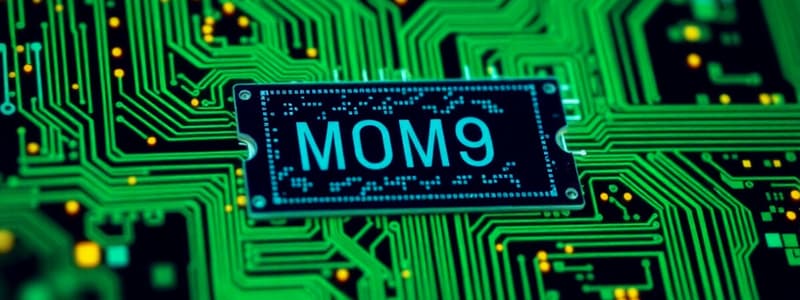Podcast
Questions and Answers
What does virtual memory allow programs to do?
What does virtual memory allow programs to do?
- Access more memory than is physically available (correct)
- Access only physical RAM
- Avoid memory management
- Run on the same physical address space
The Memory Management Unit (MMU) translates physical addresses into virtual addresses.
The Memory Management Unit (MMU) translates physical addresses into virtual addresses.
False (B)
What is a page fault?
What is a page fault?
A page fault occurs when the MMU cannot find a mapping for a virtual address.
The __________ acts as a cache to speed up address translations in virtual memory.
The __________ acts as a cache to speed up address translations in virtual memory.
Match the following components with their roles in virtual memory:
Match the following components with their roles in virtual memory:
Which of the following is NOT a benefit of virtual memory?
Which of the following is NOT a benefit of virtual memory?
Each program in a virtual memory system shares the same virtual address space.
Each program in a virtual memory system shares the same virtual address space.
What problem does memory fragmentation cause?
What problem does memory fragmentation cause?
Flashcards
Virtual Memory
Virtual Memory
A technology that enables programs to access more memory than physically available, mapping virtual addresses to physical RAM addresses.
Memory Management Unit (MMU)
Memory Management Unit (MMU)
A hardware component in the CPU responsible for translating virtual addresses into physical addresses, allowing programs to access memory seamlessly.
Virtual Addresses
Virtual Addresses
Addresses used by programs within their own virtual memory space, not reflecting the actual physical memory locations.
Physical Addresses
Physical Addresses
Signup and view all the flashcards
Page Table
Page Table
Signup and view all the flashcards
Translation Lookaside Buffer (TLB)
Translation Lookaside Buffer (TLB)
Signup and view all the flashcards
Memory Fragmentation
Memory Fragmentation
Signup and view all the flashcards
Page Fault
Page Fault
Signup and view all the flashcards
Study Notes
Virtual Memory
- Virtual Memory is a technology that allows programs to access more memory than is physically available.
- It maps virtual addresses used by applications to actual physical addresses in RAM, providing memory allocation abstraction for programs and operating systems.
- Virtual Memory History
- Previously, programs had direct access to physical RAM, assuming they were the only program running.
- This caused problems with multiple programs on a single CPU, leading to memory conflicts and fragmentation.
- How Virtual Memory Works
- The Memory Management Unit (MMU) is a hardware component in the CPU managing virtual memory.
- It translates virtual addresses into physical addresses, enabling programs to access memory without directly interacting with the physical RAM layout.
- The Operating System (OS) handles allocating and managing virtual memory for different programs, preventing interference.
- The Page table is used by the MMU to translate virtual addresses to physical addresses.
- When an application requests a virtual address, the MMU uses the page table to map it to the corresponding physical address in RAM.
- The Translation Lookaside Buffer (TLB) acts as a cache, speeding up address translations by storing recent page mappings.
- Virtual Memory Solutions
- Memory Fragmentation is a problem where unused memory becomes divided into small, isolated segments, making large memory allocations difficult. Virtual memory avoids this by allowing fragmented space to be allocated without affecting running programs.
- Address Space Management: Each program has its own virtual address space in a virtual memory system, eliminating conflicts between programs. This lets programs use memory without considering others.
- Memory Partitioning: The operating system determines and manages program memory placement and virtual/physical address mappings. This allows effective memory allocation and resource management.
- Page Fault
- A page fault occurs when the MMU cannot find a mapping for a virtual address.
- This can happen when: The program tries to access memory not allocated to it; lazy allocation occurs (OS allocated, but not yet mapped); or memory is swapped out.
- Swap Space
- The operating system uses swap space on the hard drive to temporarily store inactive pages from RAM.
- This frees up physical RAM for programs actively being used.
- Virtual Memory in Modern Computing
- Virtual memory is a key component in modern OSes.
- It enables efficient memory management and allows programs to use more memory than is physically available.
Studying That Suits You
Use AI to generate personalized quizzes and flashcards to suit your learning preferences.




